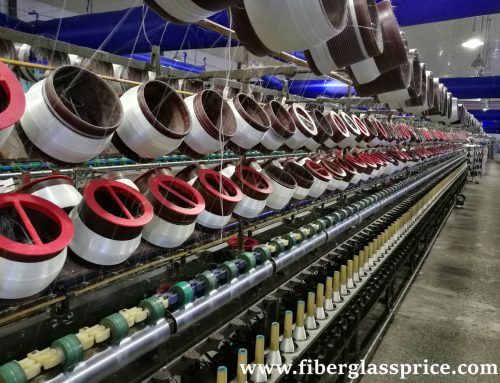Glass fiber is a very wide range of inorganic non-metallic materials, its products are mainly yarn, cloth, felt and so on. Glass fiber and its products as a composite material substrate, it has a direct impact on the performance of composite materials.In order to meet the needs of a variety of composite processes and to maintain the performance of composite materials, we must minimize the fiber surface damage and hairinessin the glass fiber production process, to maintain its original performance.
Glass fiber is a non-wearable material, the fiber in the production process to form the surface damage, hairiness and fiber and a variety of yarn material between the friction. Therefore, in order to maintain the performance of yarn, reduce yarn wear and improve production efficiency in the production process, we must choose the appropriate yarn guide material.
This paper mainly discusses the choice of glass fiber guide material from the angle of friction coefficient.
Friction coefficient between glass fiber and several materials
The friction between the glass and the yarn material is related to the friction force, and the friction force is closely related to the friction coefficient.The friction coefficient is large, under the same pressure, the friction between the glass fiber and the yarn material is large, and the damage to the fiber is also large.At present, in the process of yarn production , there has a lot of yarn materials , mainly chrome-plated metal tube, Ding Nian rubber, bamboo, all kinds of ceramics, bronze or brass, stainless steel, the material are in the form of basic cylindrical Or round hole shape, in addition to some special form.Cylindrical mainly twist machine roller, warping machine and weaving machine of the various yarn guide roller, tensioner of the various yarn guide shaft; round hole shape of the main tension of the guide wire, the whole Through the yarn frame of the guide magnetic eye, twist machine shrimp hook and so on.
Under certain conditions, by testing the glass fiber and different materials, the coefficient of friction between the material, from the perspective of friction to determine the production of glass fiber materials for the production. The test process, the main use of stainless steel, bamboo, 90 alumina, 99 alumina and other four materials produced by the yarn guide material.
Friction coefficient test between glass fiber and several materials
In this test, the selected test equipment, yarn samples, conditions and test parameters are as follows:
Test parameters:
Yarn tension: 20CN;
Yarn guide speed: 10m / min;
Test length: 50m;
Environment: temperature 23 ℃, relative humidity 60%;
Yarn type : high strength twisted yarn, 80 S / 2 * 3,55 twist / M;
The guide yarn materials: stainless steel, bamboo, 90 alumina, 99 alumina and other four kinds of material surface smooth cylindrical (the use of bamboo rod for the next year.);
Instrument: MESDAN Attrifil code 233b friction coefficient tester (Made in Italy).
Test principle: through the yarn to exert a certain tension, so that the yarn at a certain speed through the tension sensor, fine tension tensioner, guide cylinder, etc., the set of equipment connected with the computer, calculated and calculated by the corresponding software Of the friction coefficient data. The process line of the yarn passing process is shown in Fig.

During the test, stainless steel and bamboo made three sets of tests for each material; 90 alumina made two sets of tests; 99 alumina made six sets of tests. Test data and statistical results in Table 1.

Test description of friction coefficient
Due to the difference in the wetting agent, the coefficient of friction between the yarn and the yarn guide material is also different. The sizing agent for this test yarn is FE-5. Test the use of glass fiber production process common line speed and tension,different line speed and tension, the test results are not the same, so the test has relativity. However, using the same test parameters and yarn samples, the results obtained for different materials or different yarns are comparable.
Selection of guide yarn material
At present, fiberglass manufacturers in the warping machine on the yarn frame tensioner on the guide tube and compression tablets, guided magnetic eye commonly used 99 alumina, the material of the yarn material and glass fiber friction is better than other materials, But in the test process found that the friction coefficient with the glass is not low, the analysis that may be related to the use of fiber infiltration agent.

Figure 2 for the four kinds of materials and glass fiber friction coefficient. It can be seen from Figure 2 that the relationship between the friction coefficient of several materials and glass fibers is: 99 alumina> stainless steel> 90 alumina> bamboo.According to this result, we believe that bamboo is the best glass fiber guide material, and its friction coefficient is not only small, and the discrete coefficient is small, indicating that the material surface material uniform.
In the actual production process, the selection of glass fiber yarn material should also consider the yarn material angle, speed, tension and other technical factors and glass fiber specifications, the characteristics of the wetting agent and other product factors and temperature and humidity environmental factor.However, the main factors for considering the choice of the yarn material are the friction relationship between the glass fiber and the yarn guide material. In this paper, the guide yarn material of the glass fiber production process is selected from the angle of friction coefficient. The method and result of the glass fiber has a reference value to the production of the glass fiber yarn.
For more information about fiberglass yarn, please contact system@corefrp.com and our engineers will contact you at the earliest opportunity.
 The selection of yarn guide material in glass fiber production.pdf
The selection of yarn guide material in glass fiber production.pdf

